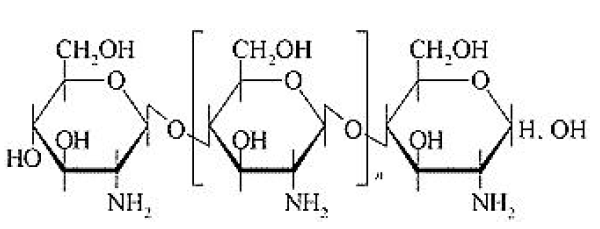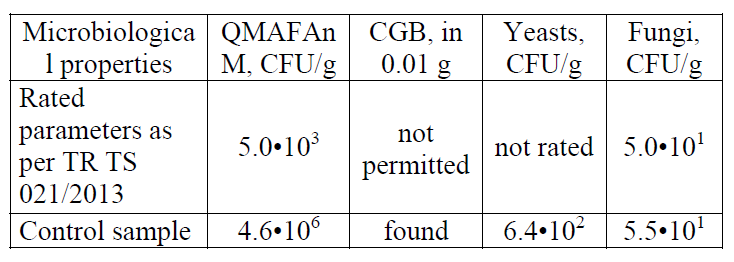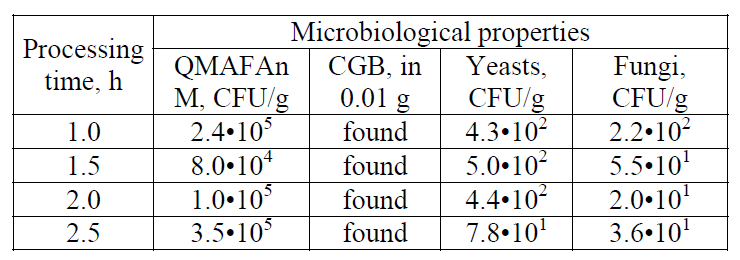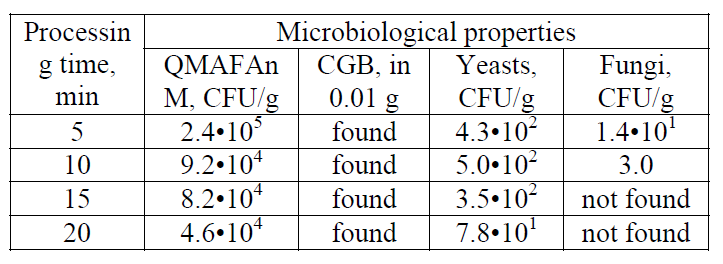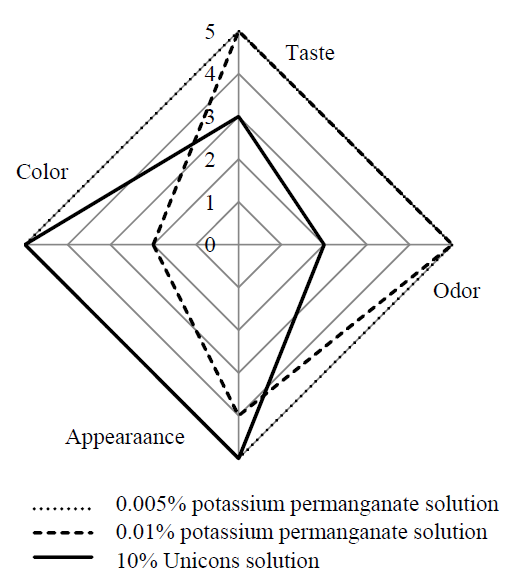Аннотация
This paper describes methods to ensure microbiological safety of sprout seeds with no loss of functional and organoleptic properties, since germination of cereal crop seeds promotes intensive growth of microorganisms. The impact of the short-wave ultraviolet irradiation for 1.0, 1.5, 2.0, 2.5 hours, the ultrasound for 5, 10, 15, 20 minutes, the antimicrobial drug solution of 3, 5, 10% in concentration for 2 and 4 minutes, solution of potassium permanganate of 0.005, 0.01, 0.05% in concentration for 2 and 4 minutes, succinic acid solution of 5% in concentration and chitosan solution of 0.1 and 0.5% in concentration in succinic acid for 20, 40, 60 minutes was identified on such microbiological properties of the germinated oat seeds, as QMAFAnM, Coliform bacteria, the amount of yeast and molds. The study results revealed that sprout oat seeds treated with ultraviolet, ultrasound, solution of antimicrobial drug of 3% and 5% concentration, succinic acid solution is not effective enough. Upon the organoleptic analysis of the resulting product, it is noted that organoleptic properties of the test product change when sprout seeds are treated with antimicrobial solution of more than 5% in concentration and with the potassium permanganate solution of more than 0.01% in concentration. The microbiological safety of sprout oat seeds is ensured without their organoleptic property changed when treated with 0.005% solution of potassium permanganate for four minutes or 0.1-0.5% solution of chitosan in succinic acid for 60 minutes. The sprout seeds thus treated may be used as the functional additive to food products.Ключевые слова
Sprout seeds, oat, microbiological safety, UV irradiation, ultrasound, antimicrobial agent, potassium permanganate, succinic acid, chitosanВВЕДЕНИЕ
The dieting pattern of the Russian population is known for inadequate consumption of biologically valuable food. Under these conditions, it is more practicable to focus on food production rich in biologically active substances, functional ingredients that beneficially impact the health and metabolism of human body [1].
Currently, more attention is paid to the use of sprout seeds of cereals and legumes as such functional ingredients. It is advisable to introduce sprout seeds to mass consumption food products.
The oat is ranked special among cereals due to the higher protein content in seeds (9.0–19.5%), and its amino acid balance that is quite successful in terms of biological value. Its composition fully complies with the standard for proteins as specified by the Food and Agricultural Organization - the UN Food and Agriculture Organization [2]. In addition, unlike wheat, rye, barley and a range of other crops, the oat does not contain gluten. Absence of allergenic properties in oat products helps to expand the range of products that do not have contraindications in case of gluten-free diet [3].
Sprouting is used to increase the biological value of seeds. As compared with the original, the sprout grain contains considerably more highly digestible vitamins and minerals and, therefore, it has a high biological value [1, 4, 5]. The content of vitamins, macro- and micro-elements such as B1, B5, B6, B9, E, silicon in sprout oat, unlike non-sprout oat, increases by 1.5 times; the content of calcium, sodium, copper, iron, zinc and tin increases twice as much; the content of vitamins B2 – 5.5 times; and the content of Vitamin C – 15.7 times [6, 7]. When germinated, the concentration of natural antibiotics and growth stimulators sharply increase in the seed [8].
In addition, when seeds are germinated, proteins decompose to amino acids due to an increase in the protease enzyme activity. The part of amino acids is digested, and the retaining volume is further decomposed to nucleotides. Thus, the protein in the germinated seed becomes easily digestible where the content of essential amino acids increases [7, 9]. During germination, the total amino acid analysis showed an increase in essential amino acids, such as lysine and tryptophan, which is responsible for the biological value promotion of germinated oat seeds [10].
When germinated, the content of antioxidants sharply increases in seeds. It is identified that the total content of water-soluble antioxidants in initial (dry) oat seeds is 34 mg per 100 g, and in sprouts - 65 and 334 mg per 100 g, respectively, on the 2nd and 5th days upon germination [11].
Thanks to a wide range of useful properties, germinated seeds of grain and legumen crops gain more popularity among many nations. Germinated seeds of various crops, food and dishes with seed sprouts, as well as seeds and devices for selfgermination are on sale.
In November 2014, the US Centers for Disease Control and Prevention reported on hospitalization of 63 people from 10 states for food poisoning due to salmonella. According to the facility, those people got poisoned with dangerous bacteria as they consumed sprout beans by the manufacturer based in New York. The US Centers for Disease Control and Preventionnoted that since 1990, sprout beans have been reported to be the cause of public poisoning in 30 cases. The reason is that this popular national product is grown under conditions favorable for harmful microorganism development: namely, in warm and humid environment [https://russian.rt.com/article/61123].
The water content in grain crops is relatively low (about 14%) preventing from the growth of microorganisms though they are found on grains in large quantities. The bulk of microorganisms appear on the grain during harvesting along with dust and soil particles [12]. The low moisture content of the grain is responsible for the inactive state of those microorganisms. However, during the grain germination and about 50% moisture content, microorganisms become active increasing in number: yeast – 5–10 times, fungi - 2.5–5 times, bacteria – 50–100 times. Therefore, microbiological surety of germinated seeds is the essential and urgent task [13] complicated by the most methods of seed treatment resulting in destruction of biologically active substances, such as vitamins, enzymes, antioxidants.
There are lots of methods known to reduce the microbiological seed contamination. Among them, there are physical (thermal and radiation) and chemical (oxidants, fumigants, inhibitors of enzymes and mycotoxins).
With high-temperature treatment regimes, the grain organoleptic properties and nutritional value unavoidably change.
One of the effective ways to solve the problem of the grain decontamination is the ultraviolet (UV) radiation use. UV radiation with the wavelengths of 205 nm to 315 nm has the bactericidal effect and efficiently inactivates various microorganisms, namely bacteria, spores, micro-fungi, etc. Unlike ionization, UV beam has the greater penetrating power and is absorbed by almost all solids. As a rule, UV photons penetrate for a few microns only; so, when solids are exposed to UV, only the thinnest layer is treated while the bulk of the substance is not affected. Accordingly, it does not change its biochemical properties. This is the advantage of UV treatment compared to other decontamination methods [14].
To date, the ultrasonic treatment of food media is under quite active discussion. UV radiation is the mechanical oscillation of over 20 kHz in frequency, which is above frequencies perceived by the human ear. The ultrasound can result in high-molecularcompound breakdown, protein coagulation, enzyme inactivation, and destruction of microorganisms [15]. The most hazardous for microorganisms is the ultrasound at 20 kHz to 100 kHz at the intensity of 0.5 - 1.0 W/cm2. Where, the treatment efficacy depends on the length of exposure, chemical composition of the medium, its viscosity, temperature, pH and initial bacterial count [16].
The advantage of food sterilization by ultrasound is that the product is not heated up to high temperatures and its taste properties remain the same. However, when using the ultrasound treatment, the low exposure intensity promotes the growth of colonies of microorganisms. The ultrasound differently affects vitamins in food products. Ascorbic acid can oxidize; B-group vitamins remain intact when exposed to lowfrequency ultrasound, and A2 and D2 vitamins - when exposed at higher frequencies [17].
Chemical antiseptics have been widely used since the second half of the XIX century, when the chemical industry proceeded to synthesize a variety of organic substances with the preserving effect. However, the health legislation of most countries sets forth strict requirements in terms of antiseptics for food preserving by limiting the types of antiseptics, their doses and a variety of food products they are allowed for [18].
It was found that the amber acid at 0.05 g/ml has the non-selective antimicrobial effect against gram-positive, gram-negative bacteria and yeast-like fungi [19].
Recently, the option to use chitosan in agriculture, ecology, industry and microbiology is of high concern [20]. Chitosan is the linear polysaccharide (Figure 1) that may be produced by chitin deacetylation, the long-chain polymer of N-acetylglucosamine that the natural part of cell wall of fungi and bacteria and is found in the exoskeleton of arthropods and a range of other invertebrates [21]. Antibacterial activity of chitosan is well known as the study was published in 1990 where 298 strains were utilized [20].
This work aims to study the efficiency of methods to ensure microbiological safety of germinated oat seeds.
ОБЪЕКТЫ И МЕТОДЫ ИССЛЕДОВАНИЯ
The target of the research are the hulless oats for germination (Obraz zhizni LLC (Lifestyle), Altai Territory).
The seed to germinate should be mellow, and comply with GOST 28673-90 "Oats. Requirements for procurement and supplies". The selected grain was washed, soaked in clean drinking water at 15–20°C for 10–12 hours, germinated at the ambient temperature of 18–23°C for 4 days.
The moisture of the germinated seeds was identified by drying in drying ovens at the temperature of (140 ± 2)°C for 40 minutes upon pre-drying at (105 ± 2)°C for 30 minutes and grinding at the laboratory mill.
The final moisture content of germinated oat seeds was about 55%. To increase the length of safe storage, preserve the quality and improve processing properties, the germinated oat seeds were dried in drying ovens to reach the moisture content of 14%.
When drying the germinated grain, the temperature of the drying agent should not exceed 45°C. An increase in the temperature of the drying agent to intensify the process may result in enzymatic hydrolysis of proteins and starch, and the considerable reduction in the content of antioxidants. Drying at low temperatures is also undesirable since it slows the process and the resulting intensive breathing causes an increase in the loss of solids and in development of microbiological processes.
The dried germinated oat seeds were crushed at the laboratory mill to particles size 1 mm, not larger.
The prepared product was exposed to the following.
(1) Ultraviolet radiation. A thin layer of the test product was placed in the laminar box with TUV (Philips) disinfection lamps and exposed to short-wave UV radiation at the wavelength of maximum 253.7 nm at 20–25°C and the relative humidity of 80% for 1, 1.5, 2 and 2.5 hours.
(2) Ultrasound. Prior to drying, the germinated oat seeds were sonicated at 35 kHz in the ultrasonic bath at 20–25°C for 5, 10, 15 and 20 minutes.
(3) The antimicrobial drug «Unicons» (Alternativa NGO) that is known for a wide range of bactericidal, fungicidal and virucidal activity. Composition: polyazolidine ammonium, 1,2,3-trihydroxypropane, water. The manufacturer recommends the external treatment by soaking or sprinkling with the solution prepared at the rate of 1 part of additive for 10–20 parts of water. Seeds were immersed in the preparation solutions concentrated at 3, 5 and 10% for 2 and 4 minutes.
(4) Potassium permanganate solution. Oat seeds were immersed in the potassium permanganate solutions concentrated at 0.005, 0.01 and 0.05% for 2 and4 minutes.
(5) Amber acid solution. The germinated seeds were immersed in 5% acid solution at the room temperature regularly stirred for 20, 40 and 60 minutes.
(6) Food chitosan (Bioprogress LLC). It is known that water-soluble chitosans are able to very quickly suppress the bacterial growth. However, this effect is less remarkable than for acid-soluble chitosans: minimal values of the inhibitory concentration of acidsoluble chitosans are much less (0.03–0.1%) than water-soluble (0.05–0.8%) [20]. The solution of 0.1 and 0.5% alimentary acid-soluble chitosan in 5% solution of amber acid was used in the work. Oat seed were treated by being immersed into 100 ml of chitosan solution at the room temperature and regular stirring for 20, 40 and 60 minutes.
To reduce the negative impact of chemicals, disinfected seeds were three times with washed up with the sterile distilled water.
Germinated oats seeds were sonicated, treated with antimicrobial solutions, potassium permanganate, amber acid and chitosan solutions in amber acid immediately as they germinated. Then, the seeds were dried and ground by the technology above.
All seed samples were tested to identify the Quantity of Mesophilic Aerobic and Facultative Anaerobic Microorganisms (QMAFAnM), Escherichia coli group bacteria (CGB), yeasts and fungi as per standard practices.
Microbiological characteristics of germinated oat seeds should comply with requirements of TR TS 021/2011 on Food Safety.
After the germinated seeds were treated, the changes in their organoleptic properties were reportedas they complied with regulatory document requirements.
РЕЗУЛЬТАТЫ И ИХ ОБСУЖДЕНИЕ
Microbiological characteristics of non-treated germinated oat seeds were determined (Table 1). As expected, samples showed Escherichia coli group bacteria and a significant number of mesophilic aerobic and optionally anaerobic microorganisms that does not meet requirements of regulatory documents; thus, the test product is not applicable for human consumption without adequate treatment.
The results of microbiological studies of UV treated germinated oat seeds are given in Table 2.
As it is seen in Table 2, when exposed to UV, the total microbial contamination decreases by an average of one order; there is no dependence on the length of treatment. The UV treated test product does not reduce the level of contamination to the acceptable level.
Changes occurring in bacteria and lower organisms exposed to UV radiation are reported to be in three stages as follow: motion excitation and enhancement, destructive change occurrence, cell death as a result of photochemical processes. The germicidal efficiency curve of UV radiation matches the absorption spectrum of nucleic acids. This means that the UV target is DNA molecules [22]. However, UV radiation of same wavelengths and same intensity is reported to cause the selective bactericidal action, that is, the dose that kills one type of bacteria only inhibits others. First of all, this is due to the unique DNA structure of each living organism. Division is the cell function most sensitive to UV rays. Certain dose of exposure causes a stop in the division of about 90% of bacterial cells. UV rays cause changes in nucleic acids that adversely affect the growth, division, heredity of cells, that is, their major manifestations of life activity [22].
Table 3 presents the results of microbiological studies of germinated oat upon after sonication.
As it is seen in Table 3, the compliance with the regulatory documentation is not reached even with ultrasonic treatment for 20 minutes. The effect of ultrasound on microorganisms is associated with the cavitation phenomenon. Cavitation is the process of cavity formation in the liquid medium filled with vapors of the liquid itself that immediately shut. The resulting pressure pulses are capable of destroying lots of biological objects, including microorganisms. To note, the phenomenon of hydrodynamic cavitation, despite the long-term studies, does not seem to be fully studied. Most researchers who studied cavitation processes agree that this phenomenon remains unpredictable in some of its manifestations [15].
Compliance of microbiological properties with regulatory documentation is reached by treating germinated oat seeds with 10% antimicrobial solution. Upon the organoleptic analysis of the resulting product it was noted that organoleptic properties of the product vary when treating germinated seeds with the antimicrobial solution "Unicons" concentrated at over 5%: unpleasant smell and flavor develop. Solutions of potassium permanganate are widely used in medicine and in food industries to inactivate microorganisms. In brewing, potassium permanganate is used to disinfect malt in the amounts of 10–15 g per 1 m3 of water.
As it is seen in Table 5, the treatment of germinated oat seeds with the potassium permanganate solution significantly reduces the level of microbiological contamination of the product. When seeds are soaked in 0.005% solution of potassium permanganate for 4 minutes, the microbiological properties of the product comply with requirements of regulatory documentation. Upon the organoleptic analysis it was noted that when the use of the potassium permanganate solution concentrated at over 0.01% results in variations of appearance of germinated oat seeds: they get darker. The results of organoleptic analysis of the test product after treatment with antimicrobial and potassium permanganate solutions are shown in Fig. 2. The results of microbiological studies of germinated oat seeds treated with solutions of amber acid and chitosan are presented in Table 6.
The treatment of oat seeds with the amber acid solution reduces the level of their microbiological contamination by an average of 2 orders. Antibacterial action of amber acid is most likely due to that organic acids are lipophilic in undissociated form, and can easily penetrate into the cytoplasm through the bacterial cell membrane. Once inside the cell, where the pH is approximately neutral, these acids dissociate, releasing protons. This results in propagation of the proton driving force that suppresses the enzyme system, transfer of nutrients, amino acids, energy metabolism and DNA synthesis. The bactericidal action of organic acids may also occur resulting from anion accumulation inside the cell. The pH lowering inside the cell causes the microbial cell to use its energy to release protons resulting in the cell depletion [19].
Nevertheless, the antimicrobial effect of amber acid is not sufficient. When chitosan concentrated at 0.1% and 0.5% is added to the amber acid solution, microbiological properties of the test product considerably improve. Moreover, the compliance with the regulatory documentation is reported when germinated seeds are treated with 0.1–0.5% chitosan solution for at least 60 minutes. In fact, chitosan directly affects the morphology of the treated microorganism. The scientific literature specifies that at pH <6.0, low-molecular chitosans are under efficient conditions for antimicrobial, antioxidant and preservative actions to occur in food products, as required. Other studies indicate that, besides its direct antimicrobial action, chitosan causes a series of plant protection reactions aimed at increasing the production of glucan hydrolases, phenolic compounds and synthesis of specific phytoalexins with antifungal action [20, 23].
No changes in organoleptic properties of germinated oat seeds treated by amber acid and chitosan are reported.
ВЫВОДЫ
By the outcome of researches conducted we may conclude that the compliance of microbiological properties of germinated oat seeds with regulatory documentation with no change in their organoleptic properties is reached by treating seeds with the potassium permanganate solution concentrated at 0.005% for 4 minutes and chitosan solution at 0.1–0.5% in 5% solution of amber acid for 60 minutes.
The chitosan solution is more preferable for germinated seed disinfection due to its properties like biodegradability, biological compatibility, nontoxicity [21, 23]. In addition, chitosan and its derivatives have a wide range of biological effect: antibacterial, fungicidal, adsorption action, antioxidant, antineoplastic, anticholesterolemic, immunoadjuvant properties [24, 25].
Thus, germinated oat seeds treated with 0.1–0.5% chitosan solution in 5% amber acid are proved to be functional product with microbiologic safety with a wide range of wholesome properties. They can be consumed directly as ready-to-use product, or as the functional food additive.
СПИСОК ЛИТЕРАТУРЫ
- Evdokimov I.A., Volodin D.N., Misyura V.A., Zolotorevа М.S., and Shramko М.I. Functional fermented milk desserts based on acid whey. Foods and Raw Materials, 2015, vol. 3, no. 2, pp. 40-48. DOI: 10.12737/13116.
- Delcour J.A. and Hoseney R.C. Principles of Cereal Science and Technology, 3d Edition. Manhattan: AACC International, 2010. 280 p.
- Batalova G.A. Perspectives and results of naked oats breeding. Legumes and groat crops, 2014, no. 2(10), pp. 64-69. (In Russian).
- Kasyanova L.А. Izmenenie khimicheskogo sostava ovsa golozernogo pri prorashhivanii [Change in chemical composition of the hulled oat during germination]. Mekhanika i modelirovanie protsessov tekhnologii [Mechanics and technical process modeling], 2012, no. 2, pp. 71-79. (In Russian).
- Hübner F. and Arendt E.K. Germination of cereal grains as a way to improve the nutritional value: A review. Critical Reviews in Food Science and Nutrition, 2013, vol. 53, no. 8, pp. 853-861. DOI: 10.1080/10408398.2011.562060.
- Shaskolskaya N.D. and Shaskolsky V.V. Samaya poleznaya eda: Prorostki [The most wholesome food: sprouts]. St. Petersburg: Vedy, Azbuka-Attikus Publ., 2011. 192 p.
- Butenko L.I. and Ligaj L.V. Researches of the chemical composition of germinated seeds of the buckwheat, oats, barley and wheat. Fundamental research, 2013, no. 4, part 5, pp. 1128-1133.
- Alekseeva T., Cheremushkina I., and Topkina Е. Biologicheski aktivnye zlakovye v obshhestvennom pitanii [Bioactive cereals for public catering]. Pitanie i obshhestvo [Food and Society], 2010, no. 8, p. 14. (In Russian).
- Evert R.F. and Eichhorn S.E. Raven Biology of Plants, 8th Edition. New York: W.H. Freeman and Company Publishers, 2013. 900 p.
- Klose C. and Arendt E.K. Proteins in oats; their synthesis and changes during germination: A review. Food Science and Nutrition, 2012, vol. 52, no. 7, pp. 629-639. DOI: 10.1080/10408398.2010.504902
- Shaskol'sky V.V. and Shaskol'skaya N.D. Antioxidant activity of the some products and sprouting seeds. Bread products, 2007, no. 12, pp. 48-50. (In Russian).
- Afanasyeva O.V. Mikrobiologiya khlebopekarnogo proizvodstva [Microbiology of breadbaking]. St. Petersburg: Beresta LLC, 2003. 220 p.
- Zharikova G.G. Mikrobiologiya prodovolstvennykh tovarov. Sanitaria i gigiena [Microbiology of food products. Sanitary and hygiene]. Moscow: ACADEMA Publ., 2005. 296 p.
- Semenov А. А. Disinfection ultraviolet radiation bulk food products. Bulletin of the National Technical University «KhPI» Series: New solutions in modern technologies, 2014, vol. 1, no. 17, pp. 25-30. (In Russian).
- Akopyan V.B. and Ershov Yu.A. Osnovy vzaimodejstviya ultrazvuka s biologicheskimi obyektami: Ultrazvuk v meditsine, veterinarii i ehksperimentalnoj biologii [Fundamentals of ultrasound interaction with biological objects: Ultrasound in medicine, veterinary medicine and experimental biology]. Moscow: BMSTU Publ., 2005. 224 p.
- Antusheva T.I. Some Features of the Effect of Ultrasound on Microorganisms. Electronic periodical “Living and Bio-inert systems”, 2013, no. 4. Available at: htpp://www.jbks.ru/archive/issue-4/article-11. (accessed 7 February 2017).
- Khmelev V.N., Slivin A.N., Barsukov R.V., Tsyganok S.N., and Shalunov A.V. Primenenie ultrazvuka vysokoj intensivnosti v promyshlennosti [Use of ultrasound of high intensity in industry]. Biysk: AltSTU Publ., 2010. 203 p.
- Lyuk E. and Yager М. Konservanty v pishhevoy promyshlennosti [Conservants in food industry]. St. Petersburg: GIORD Publ., 2000. 255 p.
- Shishkova Yu.S, Simonyan E.V., Abramovskikh O.S., et al. The study of antimicrobial activity of some dibasic carboxylic acids in combination with propolis. Medical Almanac, 2014, no. 1(31), pp. 99-101. (In Russian).
- Muzzarelli R.A.A., Boudrant J., Meyer D., et al. Current views on fungal chitin/chitosan, human chitinases, food preservation, glucans, pectins and inulin: A tribute to Henri Braconnot, precursor of the carbohydrate polymers science, on the chitin bicentennial. Carbohydrate Polymers, 2012, vol. 87, no. 2, pp. 995-1012. DOI: 10.1016/j.carbpol.2011.09.063.
- Kaplan D.L. (eds) Biopolymers from Renewable Resources. Springer-Verlag Berlin Heidelberg, 1998. 420 p. DOI: 10.1007/978-3-662-03680-8.
- Anugu A.K. Microbial inactivation and allergen mitigation of food matrix by pulsed ultraviolet light. 2013. Available at: http://ufdc.ufl.edu/UFE0045406/00001. (accessed 7 February 2017).
- Orzali L., Forni C., and Riccioni L. Effect of chitosan seed treatment as elicitor of resistance to Fusarium graminearum in wheat. Seed Science and Technology, 2014, vol. 42, no. 2, pp. 132-149. DOI: 10.15258/sst.2014.42.2.03.
- Bazunova M.V., Zaikov G.E., Zakharov V.P., and Zhukova A.N. The biological activity of citrus pectin, succinate of chitosan, and their derivates as film-forming components of the composition for seed pretreatment. Science Journal of Volgograd State University. Natural Sciences, 2015, no. 1(11), pp. 8-11. DOI: http://dx.doi.org/10.15688/jvolsu11.2015.1.1 (In Russian).
- Rinaudo M. Chitin and chitosan: properties and applications. Progress in polymer science, 2006, vol. 31, no. 7, pp. 603-632. DOI: 10.1016/j.progpolymsci.2006.06.001.


